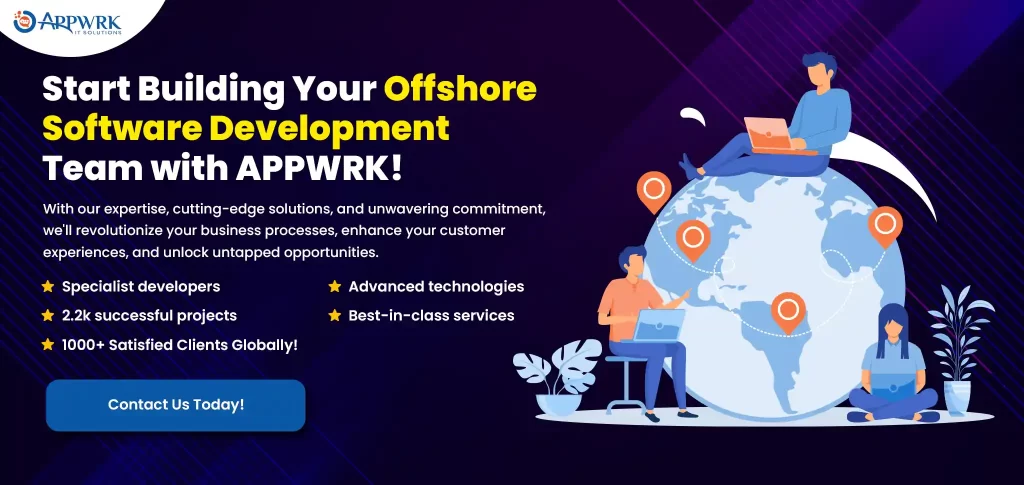Offshore Software Development – A Complete Guide with Benefits, Challenges, Cost, and More!
In the fast-paced and ever-evolving digital world, offshore software development has emerged as a game-changer for businesses seeking growth and success. With its ability to tap into a global talent pool, offshore development enables organizations to unlock the power of collaboration on a global scale.
Offshore development goes beyond geographical boundaries, connecting businesses with exceptional professionals from around the world. By embracing this approach, organizations gain access to specialized skill sets and knowledge that may be scarce or costly in their local markets. This wealth of talent fuels innovation and creativity, driving businesses toward remarkable achievements. With our guide, you’ll discover how to effectively navigate the world of offshore development, benefits, market insights, major challenges in the offshore development process, software development lifecycle, its cost, and much more which becomes helpful for your digital success.

Table of contents
- Understanding Offshore Software Development
- Benefits of Offshore Software Development
- Difference Between Onshore, Nearshore, and Offshore Software Development
- Challenges in Offshore Software Development Projects
- Offshore Software Development Lifecycle
- Factors to Consider While Choosing an Offshore Software Outsourcing Company
- Cost To Hire Offshore Developers
- Choose APPWRK – Your Offshore Software Development Company
- Conclusion
- FAQs
Understanding Offshore Software Development
Offshore software development entails the practice of outsourcing software development tasks to a team located in a different country or geographical region. It offers businesses the ability to explore the vast global talent and leverage specialized skills and expertise that may not be readily available locally. This approach exemplifies the saying, “Think globally, act locally,” as it fosters collaboration across borders, enabling organizations to access diverse perspectives and resources.
The Importance of Offshore Software Development
Offshore software development holds significant importance in today’s interconnected world. By embracing offshore development, businesses gain access to diverse talent and specialized skills, enabling them to remain competitive and agile in a rapidly changing market. The saying, “Don’t put all your eggs in one basket,” underscores the importance of diversifying resources and embracing a global perspective, which offshore software development facilitates.
The demand for offshore software development services has witnessed substantial growth in recent years. According to Statista,
- The global revenue in the IT consulting & implementation segment of the IT services market is projected to increase by a total of 17 billion U.S. dollars (+26.01 percent) between 2023 and 2027.
- In 2027, the estimated revenue in the IT consulting & implementation segment is expected to reach 82.38 billion U.S. dollars.

Benefits of Offshore Software Development
In today’s dynamic business landscape, offshore software development offers numerous advantages that can propel organizations toward success. Let’s explore the key advantages that illustrate the transformative power of offshore development.
1. Cost Reduction
Offshore software development presents a significant opportunity for cost reduction. By leveraging regions with lower labor costs, businesses can optimize their budgets and allocate resources strategically. This cost advantage allows organizations to invest in other critical areas such as research and development or marketing.
2. Access to Specialized Skills
Offshore software development provides businesses with access to global talent and specialized skills that may be scarce or expensive locally. This advantage allows organizations to tap into niche expertise and cutting-edge technologies.
3. Scalability and Flexibility
Custom software development enables organizations to scale their teams quickly and efficiently. As businesses expand, the need for additional resources arises, and offshore development offers a flexible solution.
4. Time Zone Advantage
Offshore software development teams located in different time zones can provide a time-zone advantage. This allows for a seamless workflow and round-the-clock productivity. For instance, Company A, a global financial services provider, collaborated with an offshore development team in a different time zone. By leveraging the time zone difference, they achieved continuous progress on their projects. While the onshore team was completing their workday, the offshore team continued working, resulting in accelerated project timelines and enhanced productivity.
Difference Between Onshore, Nearshore, and Offshore Software Development
In the realm of software development, organizations have various options when it comes to sourcing talent and services. Understanding the differences between onshore, nearshore, and offshore software development is essential for businesses aiming to make informed decisions and leverage the most suitable approach for their needs. Let’s explore these distinctions and unlock the key factors that set them apart.
Onshore Software Development
Onshore software development refers to sourcing talent and services within the same country or geographical region as the business. With onshore development, organizations benefit from close proximity, allowing for easier communication, face-to-face meetings, and real-time collaboration. This approach follows the saying, “Two heads are better than one,” as it fosters strong collaboration between the business and the development team. Onshore development is often preferred for projects requiring a high level of coordination and frequent interaction.
Nearshore Software Development
Nearshore software development involves sourcing talent and services from a neighboring country or a nearby geographical region. This approach offers a balance between proximity and cost advantages. Organizations can tap into talent pools that are geographically close, ensuring easier travel, cultural alignment, and collaboration. The adage, “A stitch in time saves nine,” captures the cost advantages of nearshore development. By leveraging neighboring regions with lower labor costs, businesses can achieve cost optimization while maintaining the benefits of geographic proximity.
Offshore Software Development
Offshore software development involves sourcing talent and services from a different country or a distant geographical region. This approach allows organizations to access global talent and leverage cost efficiency. Offshore development follows the saying, “Think globally, act locally,” as it enables businesses to tap into specialized skills and expertise that may not be readily available domestically. Offshore development offers significant cost advantages by leveraging regions with lower labor costs. This cost efficiency allows organizations to optimize their budgets and allocate resources strategically.

Choosing the Right Approach for Your Business
When deciding between onshore, nearshore, and offshore software development, several factors come into play. The nature of the project, budget considerations, and the need for collaboration and proximity all influence the decision-making process. For projects requiring close collaboration and real-time communication, onshore development may be the preferred choice. If cost optimization and cultural alignment are paramount, nearshore development offers a balance between proximity and affordability. In contrast, offshore development is ideal for accessing global talent, specialized skills, and achieving significant cost savings.
Challenges in Offshore Software Development Projects
Offshore software development projects bring numerous advantages, but they also present unique challenges that must be addressed for successful outcomes. By recognizing and tackling these challenges head-on, businesses can ensure smooth project execution and maximize the benefits of offshore collaboration. Let’s explore common challenges faced in offshore projects, along with effective solutions that emphasize the importance of communication and project management.
1. Communication and Language Barriers
Effective communication is the cornerstone of successful offshore software development projects. Language barriers, differences in communication styles, and varying time zones can pose challenges. The proverb, “Actions speak louder than words,” highlights the significance of clear communication. Mitigate these challenges by establishing a communication plan that includes regular meetings, clear documentation, and the use of collaborative tools. Encourage open dialogue, active listening, and provide language support if necessary to foster effective cross-cultural communication.
2. Cultural Differences and Expectations
Cultural differences can impact the understanding of requirements, work approaches, and expectations. Embracing the proverb, “When in Rome, do as the Romans do,” businesses should strive to bridge cultural gaps and foster understanding. Invest time in learning about the cultural nuances of the offshore team’s location and share insights about the organization’s work culture and values. Define common ground and set clear expectations from the outset to align work processes, deadlines, and quality standards.
3. Time Zone Challenges
Working across different time zones can lead to coordination and collaboration challenges. However, with careful planning, these challenges can be mitigated. The saying, “Time is of the essence,” resonates here. Establish overlapping work hours to facilitate real-time collaboration, and leverage project management tools that allow for asynchronous communication. Clearly define and communicate deadlines, milestones, and response time expectations to ensure smooth workflow and effective task management across time zones.
4. Quality Assurance and Risk Management
Maintaining consistent quality standards and managing project risks are crucial for offshore software development projects. The adage, “Forewarned is forearmed,” emphasizes the importance of proactive risk management. Implement thorough quality assurance processes, such as regular code reviews, testing, and documentation standards. Foster a culture of accountability and transparency within the offshore team, encouraging them to identify and address risks promptly. Regularly assess project progress and conduct periodic reviews to identify potential issues and take corrective actions.
5. Project Management and Coordination
Effective project management is vital for the success of offshore software development projects. Clear project planning, defined roles and responsibilities, and streamlined coordination are essential. The proverb, “Many hands make light work,” applies here. Appoint a dedicated project manager or establish a project management office (PMO) to oversee the project, facilitate communication, and ensure that tasks are executed as per the plan. Leverage project management methodologies, such as Agile or Scrum, to enhance transparency, adaptability, and collaboration.
Offshore Software Development Lifecycle
The offshore software development lifecycle is a structured approach that guides businesses through the process of executing successful projects with offshore development teams. By following these steps, Offshore software development companies can ensure smooth collaboration, effective communication, and timely delivery of high-quality software solutions. Let’s explore the key steps involved in the offshore software development lifecycle and discover how they contribute to project success.

1. Project Planning: Setting the Course for Success
The first step in the offshore software development lifecycle is project planning. This involves defining project objectives, scope, and timelines. The proverb, “Failing to plan is planning to fail,” highlights the importance of careful planning. During this stage, businesses identify project requirements, allocate resources, and establish communication channels with the offshore team. Clear documentation and effective communication are crucial to align expectations and set a solid foundation for the project.
2. Requirements Gathering: Capturing the Vision
Requirements gathering involves eliciting and documenting the functional and non-functional requirements of the software solution. Engaging stakeholders, users, and subject matter experts is essential to capture a comprehensive understanding of the project’s vision and goals. The adage, “The devil is in the details,” underscores the significance of thorough requirement gathering. Clear and concise documentation of requirements ensures that the offshore development team understands the project’s scope and can deliver according to expectations.
3. Development: Transforming Vision into Reality
The development phase is where the software solution takes shape. The offshore development team starts coding, designing, and building the application based on the documented requirements. Regular communication, collaboration, and progress tracking are crucial during this stage. The proverb, “Rome wasn’t built in a day,” reminds us that quality software development requires time and attention to detail. By fostering effective communication and providing timely feedback, businesses can ensure that the development process aligns with project goals and timelines.
4. Testing and Quality Assurance: Ensuring Reliability and Performance
Testing and quality assurance are vital steps in the offshore software development lifecycle. Thorough testing helps identify and fix software defects, ensuring that the solution meets the required quality standards. The adage, “Measure twice, cut once,” highlights the importance of thorough testing to prevent potential issues and rework. The offshore team conducts various types of testing, including functional, performance, and security testing, to ensure the reliability, scalability, and security of the software solution.
5. Deployment and Support: Bringing the Solution to Life
The final stage of the offshore software development lifecycle involves deploying the software solution and providing ongoing support. This includes configuring the application, performing system integration, and ensuring a smooth transition to the production environment. The saying, “The end is just a new beginning,” applies here, as post-deployment support and maintenance are essential to address any issues and ensure optimal performance. Continuous support and collaboration with the offshore team contribute to long-term success and customer satisfaction.
Factors to Consider While Choosing an Offshore Software Outsourcing Company
When selecting an offshore outsourcing software development company or offshore software development center, several factors come into play. Evaluating these factors can help businesses make informed decisions and find the right partner for their development needs. The proverb, “Choose your friends wisely,” applies here. Consider the following factors when choosing an outsourcing partner:
Expertise and Experience
Assess the outsourcing company’s expertise in the technology stack and domain relevant to your project. Look for a track record of successful project delivery and client testimonials that speak to their experience and expertise.
Cultural Alignment
Cultural alignment is crucial for seamless collaboration. Evaluate whether the outsourcing company’s work culture aligns with your organization’s values and communication styles. Seek insights into their approach to teamwork, transparency, and adaptability.
Communication and Language Skills
Effective communication is vital in offshore collaboration. Ensure that the offshore software development outsourcing company has proficient English language skills and demonstrates excellent communication abilities. Regular and clear communication bridges geographical gaps and ensures project success.
Quality Assurance Practices
Quality assurance is critical for delivering robust and reliable software solutions. Evaluate the outsourcing company’s quality assurance practices, such as code reviews, testing methodologies, and adherence to industry standards. Look for certifications or frameworks they follow, such as ISO or CMMI.
Security Measures
Protecting sensitive data and intellectual property is paramount. Assess the outsourcing company’s security measures, data protection policies, and compliance with relevant regulations, such as GDPR or HIPAA. A secure partnership fosters trust and mitigates risks.
Tips for Evaluating Offshore Software Developers:
a. Request and review their portfolio, focusing on projects similar to yours.
b. Seek client references and testimonials to validate their expertise and reliability.
c. Conduct technical interviews or coding tests to assess their technical proficiency.
d. Consider cultural fit by engaging in open conversations about work values and collaboration.
e. Assess their communication skills through interviews, video conferences, or trial projects.
f. Establish clear expectations and goals upfront to ensure alignment and avoid misunderstandings.
g. Consider the offshore team’s experience with Agile methodologies and project management tools.
h. Evaluate their ability to adapt to your project’s changing needs and handle potential challenges.

Cost To Hire Offshore Developers
When it comes to offshore software development, the cost can vary significantly depending on the location of the team you choose to work with. Different regions around the world have different offshore software development rates for specialized professionals, and this, in turn, affects the overall development costs.
| Outsourcing Regions | Standard Hourly Rates For Work (in US dollars) |
| Central Europe | 25-100 |
| Western Europe | 50-200 |
| North America | 100-149 |
| South America | 35-70 |
| Asia | 20-45 |
At APPWRK IT Solutions, we take pride in being an India-based company that serves clients globally. With a strong focus on offshore software development, we offer a comprehensive range of services tailored to meet the diverse needs of our clients. Our team of highly skilled and experienced professionals is well-versed in delivering top-notch solutions across various industries.
Our Offshore developer’s hourly rate starts from $18/per hour only. At the most affordable pricing, we also guarantee the best of the services in terms of quality. You can check more about Our Pricing, Client Testimonials or simply Contact Us here.
Offshore Software Development Trends to Watch
The offshore software development industry is continuously evolving, driven by emerging trends and technologies that shape the way projects are executed and software solutions are delivered. Staying informed about these trends is essential for businesses aiming to remain competitive in the ever-changing digital landscape. Let’s explore some of the key offshore software development trends and their impact on the industry, with a particular focus on artificial intelligence (AI), blockchain, and cloud computing.
1. Artificial Intelligence (AI)
Artificial intelligence is revolutionizing offshore software development, enabling businesses to automate tasks, improve decision-making, and enhance overall efficiency. AI-powered tools and frameworks are streamlining various aspects of the development lifecycle, from requirement analysis to code generation and testing. The proverb, “Work smarter, not harder,” encapsulates the essence of AI’s impact on offshore development. Embracing AI can result in faster development cycles, improved accuracy, and reduced time-to-market.
2. Blockchain
Blockchain technology is gaining momentum in the offshore software development industry, offering secure and transparent solutions for data storage and transactional processes. It’s decentralized nature and cryptographic mechanisms provide enhanced security and trust, making it ideal for applications requiring immutability and data integrity. The adage, “Trust, but verify,” resonates strongly with the impact of blockchain on offshore development. Leveraging blockchain can bring increased data security, efficient record-keeping, and streamlined supply chain management.
3. Cloud Computing
Cloud computing has revolutionized the way software is developed and deployed, making it a significant trend in offshore development. The cloud offers scalable infrastructure, on-demand resources, and cost optimization opportunities. Offshore development teams can leverage cloud platforms to develop, test, and deploy applications efficiently. The saying, “The sky is the limit,” illustrates the unlimited potential of cloud computing for offshore development. By embracing the cloud, businesses can achieve scalability, flexibility, and improved collaboration across distributed teams.
4. Agile and DevOps Practices
Agile methodologies and DevOps practices continue to shape offshore software development, emphasizing collaboration, continuous integration, and rapid delivery. These approaches promote iterative development, cross-functional teamwork, and continuous feedback loops. The proverb, “Two heads are better than one,” captures the essence of Agile and DevOps in offshore development, where close collaboration between onshore and offshore teams is vital. Adopting Agile and DevOps practices allows businesses to achieve faster time-to-market, higher customer satisfaction, and adaptability to changing project requirements.
5. Internet of Things (IoT)
The Internet of Things (IoT) is driving the need for innovative software solutions, creating new opportunities for offshore development. IoT devices and systems require sophisticated software to enable seamless connectivity and data management. Offshore development teams with expertise in IoT can help businesses develop robust and scalable solutions for smart homes, industrial automation, healthcare, and more. The adage, “The world is your oyster,” reflects the vast possibilities offered by IoT in offshore development, unlocking new avenues for growth and innovation.
Choose APPWRK – Your Offshore Software Development Company
We understand that selecting the right offshore development company can be a daunting task. However, APPWRK IT Solutions is here to provide you with the perfect solution. With a team of 110+ subject matter experts across various leading technologies including React JS, Angular, Webflow, Laravel, Shopify, and more, we are equipped to handle your software projects with excellence. Our experts work seamlessly across different time zones, ensuring timely updates and efficient collaboration.
APPWRK IT Solutions takes pride in having successfully delivered over 3000+ digital products across a wide range of industries. Our track record speaks for itself, as we have helped numerous entrepreneurs realize their dreams of building digital empires. By partnering with us, you gain access to our pool of experts who are well-versed in both established and emerging technologies.
We prioritize effective communication and work according to the time zones that suit our clients’ needs. Rest assured, you will receive regular updates on the progress of your projects. Our competitive price quotes ensure that you receive exceptional value for your investment. With APPWRK IT Solutions, you can trust that your software projects are in the hands of experienced professionals who are dedicated to your success.
Conclusion
In this comprehensive guide to offshore software development, we have explored various aspects that businesses must consider to navigate the path to success. From understanding the significance of offshore development in the digital era to delving into the differences between onshore, nearshore, and offshore approaches, we have gained valuable insights into this dynamic field.
In conclusion, offshore software development presents immense potential for businesses to leverage global talent, optimize costs, and drive innovation. By following best practices, selecting the right outsourcing partner, fostering effective communication, and embracing emerging trends, organizations can unlock the true power of offshore collaboration. Remember, offshore software development is a strategic journey that requires careful planning, cultural understanding, and continuous adaptation. With the right approach and a commitment to excellence, businesses can embark on a successful offshore development journey and achieve their goals in the ever-evolving digital landscape.

Make the right choice and partner with APPWRK IT Solutions today. Experience the difference that our expertise, commitment, and efficient project management can bring to your software development endeavors. Contact us now to discuss your project requirements and take the first step toward transforming your ideas into reality.
FAQs
Offshore software development refers to the practice of outsourcing software development projects to teams or companies located in different countries or geographical regions. It involves leveraging the expertise, cost advantages, and specialized skills available in offshore locations to develop software solutions.
Offshore software development offers several benefits, including cost optimization, access to global talent pools, scalability, and time zone advantages. By partnering with offshore development teams, businesses can reduce development costs, tap into specialized skills, and leverage the flexibility and scalability of offshore resources.
Selecting the right offshore software development company requires careful consideration. Factors to consider include the company’s expertise, experience, cultural fit, communication capabilities, quality assurance practices, and security measures. Evaluating their track record, client testimonials, and portfolio can help assess their capabilities and reliability.
Onshore software development involves sourcing talent and services within the same country or geographical region as the business. Nearshore software development refers to outsourcing to neighboring or nearby countries. Offshore software development involves partnering with teams in distant countries or regions. The choice depends on factors such as proximity, cost advantages, cultural alignment, and access to specific skills and expertise.
Effective communication is vital in offshore software development. Establish clear communication channels, leverage collaboration tools and technologies, and define regular meeting schedules. Encourage open dialogue, and active listening, and provide language support if necessary. Regularly update and share project documentation to ensure everyone is on the same page.
Offshore software development projects may face challenges such as language barriers, cultural differences, time zone variations, and potential communication gaps. Other challenges include maintaining quality standards, ensuring data security, and managing project risks. However, these challenges can be mitigated through careful planning, effective communication, cultural understanding, and proactive risk management.
To maximize the success of offshore software development projects, focus on clear project planning, thorough requirement gathering, effective communication and collaboration, adherence to quality assurance practices, and proactive risk management. Establishing trust, fostering a team culture of accountability, and embracing emerging trends and technologies can also contribute to project success.

About The Author
























































